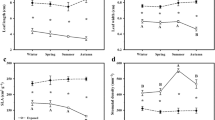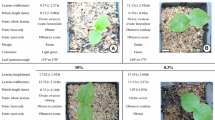Abstract
Adaptive values of plasticity in Iris pumila leaf traits (morphological: SLA, specific leaf area; anatomical: SD, stomatal density; LT, leaf thickness; VBN, vascular bundle number; SW, sclerenchyma width; CW, cuticle width, and physiological: ChlT, total chlorophyll concentration; ChlA/B, chlorophyll a/b ratio) were tested at three irradiance levels in a growth-room. Siblings from 28 full-sib families from an open dune site and a woodland understory responded similarly to variation in light availability: SLA gradually increased, while anatomical and physiological traits decreased with light reduction. In the Dune population, standardized linear selection gradients were significant for SLA and ChlT at high light, VBN along the entire light gradient, SW at high- and low-, and ChlA/B at low-irradiance. In the Woods population, the significant standardized linear selection gradients were observed for SLA and LT at low- and VBN at both high- and low-irradiance. A significant nonlinear selection gradient was recorded for SD and LT at medium irradiance. Comparisons of the plastic responses to each light quantity with the phenotypes favored by selection in that environments revealed that only an increased SLA value at low light in the Woods population was ecologically significant (adaptive). In the Dune population, SD and VBN entailed plasticity costs at low irradiance, while a cost of homeostasis was recognized for ChlT and ChlA/B at medium light, SD and CW at high- and low-, and SLA at high- and medium-light level. In the shaded population, CW and ChlA/B incurred plasticity costs at high irradiance, while for ChlT plasticity costs appeared under medium- and low-light conditions. In all leaf traits, genetic variation for plasticity was statistically undetectable. Genetic correlations between these traits were mostly insignificant, implying that they possess a capability for relatively independent evolution by natural selection across different light environments.

Similar content being viewed by others
References
Ayres MP, Thomas DL (1990) Alternative formulations of the mixed-model ANOVA applied to quantitative genetics. Evolution 44:221–226
Björkman O (1981) Responses to different quantum flux densities. In: Lange OL, Nobel PS, Osmond CB, Ziegler H (eds) Physiological plant ecology I. Encyclopedia of plant physiology. Springer-Verlag, Berlin, pp 57–101
Bradshaw AD (1965) Evolutionary significance of phenotypic plasticity in plants. Adv Genet 13:115–155
Cao K, Booth EW (2001) Leaf anatomical structure and photosynthetic induction for seedlings of five dipterocarp species under contrasting light conditions in a Bornean heath forest. J Trop Ecol 17:163–175
DeWitt TJ (1998) Costs and limits of phenotypic plasticity: Tests with predator-induced morphology and life history in a freshwater snail. J Evol Biol 11:465–480
Dorn LA, Pyle EH, Schmit J (2000) Plasticity to light cues and resources in Arabidopsis thaliana: testing for adaptive value and costs. Evolution 54:1982–1994
Dudley SA (1996) Differing selection on plant physiological traits in response to environmental water availability: a test of adaptive hypotheses. Evolution 50:92–102
Dudley SA, Schmitt J (1996) Testing the adaptive plasticity hypothesis: density dependent selection on manipulated stem length in Impatiens capensis. Am Nat 147:445–465
Efron B (1982) The Jackknife, the Bootstrap, and Other Resampling Plans. Soc. Indust. Appl. Math. Philadelphia, PA
Endler JA (1986) Natural selection in the wild. Princeton University Press, Princeton, New Jersey, USA
Fry JD (1992) The mixed-model analysis of variance applied to quantitative genetics: biological meaning of the parameters. Evolution 46:540–550
Hiscox JD, Israelstam GF (1979) A method for the extraction of chlorophyll from leaf tissue without maceration. Can J Bot 57:1332–1334
King DA (1991) Correlations between biomass allocation, relative growth rate and light environment in tropical forest saplings. Funct Ecol 5:485–492
Lande R, Arnold SJ (1983) The measurement of selection on correlated characters. Evolution 37:1210–1226
Lichtenthaler HK (1996) Vegetation stress: an introduction to the stress concept in plants. J Plant Physiol 148:4–14
Little TM, Hills FJ (1978) Agricultural Experimentation: design and analysis. Wiley, New York
Mitchell-Olds T, Shaw RG (1987) Regression analysis of natural selection: statistical inference and biological interpretation. Evolution 41:1149–1161
Nadeau JA, Sack FD (2002) Control of stomatal distribution on the Arabidopsis leaf surface. Science 296:1697–1700
Nicotra AB, Chazdon RL, Schlichting CD (1997) Patterns of genotypic variation and phenotypic plasticity of light response in two tropical Piper (Piperaceae) species. Am J Bot 84:1542–1552
Oguchi R, Hikosaka K, Hirose T (2003) Does the photosynthetic light-acclimation need change in leaf anatomy? Plant Cell Environ 26:505–512
Pazourek J (1970) The effect of light intensity on stomatal frequency in leaves of Iris holandica hort., var.Wedgwood. Biol Plant 12:208–215
Pemac D, Tucić B (1998) Reaction norms of juvenile traits to light intensity in Iris pumila (Iridaceae): a comparison of populations from exposed and shaded habitats. Plant Syst Evol 209:159–176
Poorter L (2001) Light-dependent changes in biomass allocation and their importance for growth of rain forest tree species. Funct Ecol 15:113–123
Poulton J, Winn AA (2002) Costs of canalization and plasticity in response to neighbors in Brassica rapa. Plant Species Biol 17:109–118
Rice WR (1989) Analyzing tables of statistical tests. Evolution 43:223–225
SAS Institute (1989) SAS/STAT user’s guide, version 6.4. SAS Institute Inc., Cary N.C.
Scheiner SM, Berrigan D (1998) The genetics of phenotypic plasticity. VIII. Cost of plasticity in Daphnia pulex. Evolution 52:368–378
Schlichting CD (1986) The evolution of phenotypic plasticity in plants. Annu Rev Ecol Syst 17:667–693
Shipley B, Keddy PA (1988) The relationship between relative growth rate and sensitivity to nutrient stress in twenty-eight species of emergent macrophytes. J Ecol 76:1101–1110
Sokal RR, Rohlf FJ (1981) Biometry Second Edition. Freeman, San Francisco
Steinger T, Roy BA, Stanton ML (2003) Evolution in stressful environment II: adaptive value and costs of plasticity in response to low light in Sinapis arvensis. J Evol Biol 16:313–323
Sultan SE (1992) Phenotypic plasticity and the Neo-Darwinian legacy. Evol Trends Plants 6:61–71
Sultan SE (1995) Phenotypic plasticity and plant adaptation. Acta Bot Neerl 44:363–383
Sultan SE (2003) Phenotypic plasticity in plants: a case in ecological development. Evol Dev 5:25–33
Sultan SE, Bazzaz FA (1993) Phenotypic plasticity in Poligonum persicaria.I. Diversity and uniformity in genotypic norms of reaction to light. Evolution 47:1009–1031
Tucić B, Avramov S (1996) Maternal effects on early juvenile traits in Iris pumila (Iridaceae). Plant Syst Evol 201:179–197
Tucić B, Milojković S, Vujčić S, Tarasjev A (1988) Clonal diversity and dispersion in Iris pumila Acta Oecologica. Oecologia Plant. 9:211–219
Tucić B, Tomić V, Avramov S, Pemac D (1998) Testing the adaptive plasticity of Iris pumila leaf traits to natural light conditions using phenotypic selection analysis. Acta Oecologica 19:473–481
Tucić B, Pemac D, Stojković B, Avramov S (1999) Coping with environmental changes in Iris pumila: a pilot experiment. Arch Biol Sci 51:137–148
Tucić B, Stojković B (2001) Shade avoidance syndrome in Picea omorika seedlings: a growth-room experiment. J Evol Biol 14:444–455
Tucić B, Pemac D, Dučić J (2005) Life history responses to irradiance at the early seedling stage of Picea omorica (Pančić) Purkyňe: adaptiveness and evolutionary limits. Acta Oecologica 27:185–195
Valladares F, Pearcy RW (1998) The functional ecology of shoot architecture in sun and shade plants of Heteromeles arbutifolia M. Roem., a Californian chaparral shrub. Oecologia 114:1–10
Van Kleunen M, Fischer M, Schmid B (2000) Costs of plasticity in foraging characteristics of the clonal plant Ranunculus reptans. Evolution 54:1947–1955
Van Tienderen PH (1991) Evolution of generalists and specialists in spatially heterogeneous environments. Evolution 45:1317–1331
Via S, Lande R (1985) Genotype–environment interaction and the evolution of phenotypic plasticity. Evolution 39:505–522
Wade MJ, Kalisz S (1990) The causes of natural selection. Evolution 44:1947–1955
Weeks SC, Meffe GK (1996) Quantitative genetics and optimality analyses of life-history plasticity in the eastern mosquitofish, Gambusia holbrooki. Evolution 50:1358–1365
Wild A, Wolf G (1980) The effect of different light intensities on the frequency and size of stomata, the size of cells, the number, size and chlorophyll content of chloroplasts in the mesophyll and the guard cells during the ontogeny of primary leaves of Sinopis alba. Z Pflanzenphysiol 97:25–342
Acknowledgments
This research was supported by the Ministry of Science, Technology and Development of Serbia, Grant #143033. We are grateful to the associated editor Kevin L. Griffin and two anonymous reviewers for their constructive comments on the manuscript.
Author information
Authors and Affiliations
Corresponding author
Rights and permissions
About this article
Cite this article
Avramov, S., Pemac, D. & Tucić, B. Phenotypic plasticity in response to an irradiance gradient in Iris pumila: adaptive value and evolutionary constraints. Plant Ecol 190, 275–290 (2007). https://doi.org/10.1007/s11258-006-9207-3
Received:
Accepted:
Published:
Issue Date:
DOI: https://doi.org/10.1007/s11258-006-9207-3




